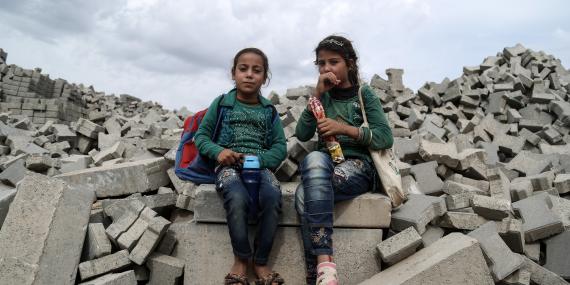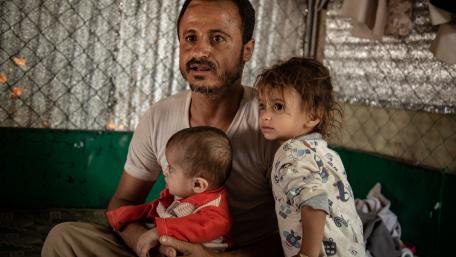North-west Syria
Thousands of people in north-west Syria remain displaced. Violence forced families from their homes, and 80 per cent of the displaced were women and children. Many left on foot, taking just what they could carry, and moved to over-crowded camps with limited shelter and sanitation facilities. Some families have been living in these camps for several years as they were forced from their homes by conflict. WFP/Photolibrary
The intensity of political conflicts has not slowed down. 2019 was marked by the continuation of many highly violent political conflicts. In that year, about 55 per cent of 358 political conflicts worldwide involved the use of violence. Of those conflicts, 38 were highly violent. Geopolitical tensions were on the rise even before the pandemic. They have prolonged violent conflict, contributing to “difficulty in getting policymakers to come together, [and] find collaborative, cooperative solutions.”
Survivors of conflict-related sexual violence, primarily women and girls, face social, structural and security constraints. This often leads to negative coping mechanisms, including early and forced marriage. Children remain disproportionately affected by conflict. In 2019, the UN verified over 25,000 grave violations against children including killing and maiming, recruitment of children as soldiers, sexual violence and abductions, as well as 927 attacks on schools and hospitals.
Conflicts by level of intensity (2014-2019)
Humanitarian access and operations continue to be hampered by conflict and insecurity. Measures to contain the spread of COVID-19 have increased or amplified humanitarian access constraints due to national and international mobility restrictions for cargo and personnel. These restrictions have also triggered delays, additional costs and the partial suspension of humanitarian activities. Violence against aid workers, including killings and assaults, arbitrary detention, harassment, theft and military use of humanitarian premises, continues to be widespread. It is important to ensure that counterterrorism and sanctions measures do not restrict humanitarian access.
Attacks against health-care workers persist. WHO recorded over 1,000 incidents in 2019, including destroyed hospitals, attacks on medical workers, removal of supplies and military use of medical facilities.
Aid worker security incidents (2010–2019)
Civilian populations continue to bear the brunt of the use of explosive weapons in populated areas. For the ninth consecutive year, civilians accounted for more than 90 per cent of total casualties of the use of explosive weapons in populated areas: in 2019, bombing, shelling and the use of other explosive weapons in populated areas killed, maimed or injured at least 17,904 people. In 2020, pandemic-related containment measures appeared to reduce the number of people killed or injured by explosive weapons, with reports indicating a 58 per cent drop in civilian harm compared to 2019. Air strikes in particular have been largely suspended during lockdown. April to July 2020 saw 160 incidents compared to 554 the previous year. It remains to be seen whether the drop in violence will endure as confinement measures are lifted.
On 23 March 2020, the UN Secretary-General appealed for an immediate global ceasefire, supported by the Security Council, the General Assembly, Member States, regional organizations, armed groups and civil society. However, the pandemic is expected to spark further conflict and violence as countries experience civil unrest, political destabilization, and increases in crime, anti-refugee sentiment and suspicion of humanitarian workers. This will exacerbate existing insecurity, of which civilians will again bear the brunt.
Further reading
Source: Heidelberg Institute for International Conflict Research
Source: Office for the Coordination of Humanitarian Affairs
Source: Action on Armed Violence
References
- Political conflict is classified according to its intensity into low, medium or high. Low intensity political conflict is non-violent; it includes political disputes and non-violent crises. Medium and high intensity political conflict includes the use of violence. Specifically, highly violent political conflicts include 15 wars and 23 limited wars. For full definitions on methodology, please see Heidelberg Institute for International Conflict Research, Conflict Barometer 2019
- Lowcock, COVID-19 effects could deteriorate into 2021 and beyond, UN's Mark Lowcock says – Devex interview, 21 September 2020
- Report of the UN Secretary-General on Conflict-Related Sexual Violence, S/2020/487, 3 June 2020
- Report of the UN Secretary-General on Children and Armed Conflict, A/74/845–S/2020/525, 9 June 2020. The highest numbers were verified in the Syrian Arab Republic, the Occupied Palestinian Territory, Afghanistan and Somalia. 2019 saw some 4,400 incidents of denial of humanitarian access to children.
- Sophie Solomon, Humanitarian Access in the Time of Coronavirus: We Adapt, We Innovate and we Adapt Some More, UN OCHA on Medium, 20 May 2020.
- Report of the UN Secretary-General on the Protection of Civilians in Armed Conflict, S/2020/366, 6 May 2020.
- United Nations, Report of the UN Secretary-General on the Protection of Civilians in Armed Conflict, S/2020/366, 6 May 2020
- Action on Armed Violence, Explosive Violence in 2019, 7 January 2020.
- The United Nations Secretary-General’s Call For a Global Ceasefire: Challenges and Opportunities
- See Resolution adopted by the UN General Assembly on 2 April 2020 (A/RES/74/270); Resolution adopted by the UN Security Council on 28 June 2020 (S/RES/607).





